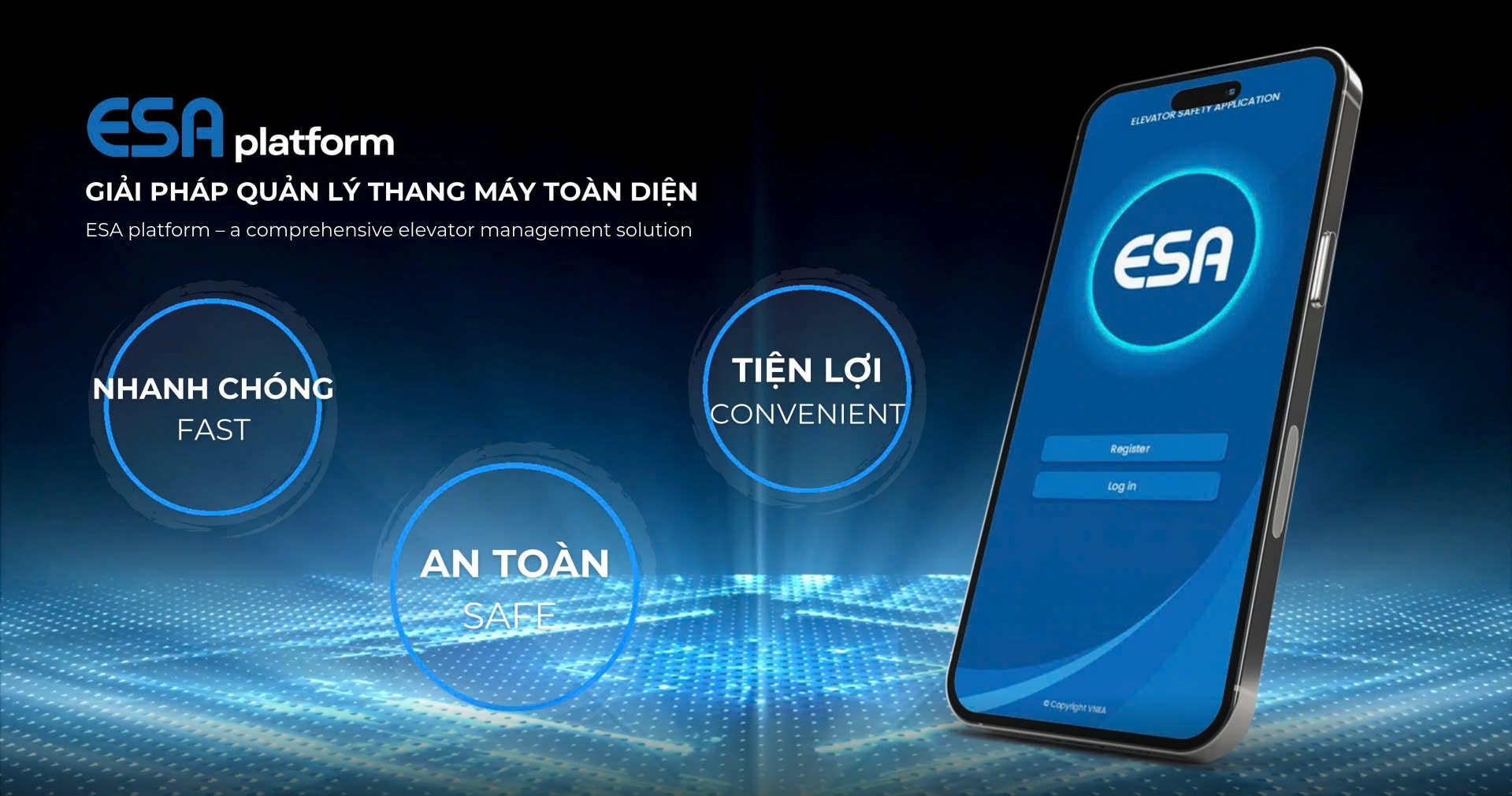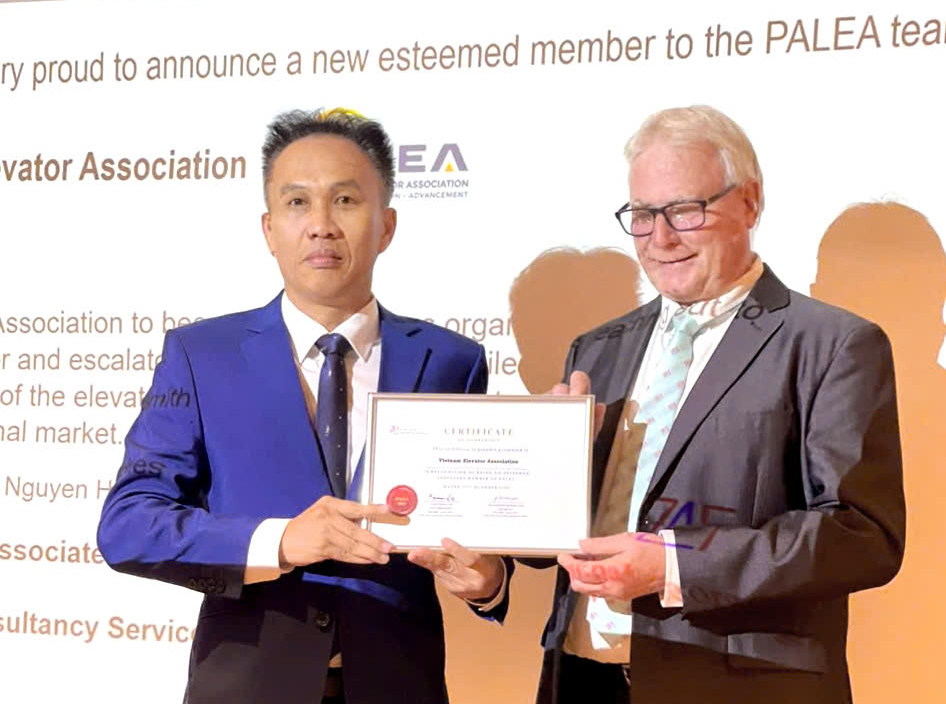Vietnam Elevator Association introduces Elevator Safety Application to the world
It is expected that this platform will manage 300,000 elevators in Vietnam, contributing to accelerating the urban infrastructure modernisation process and addressing the urgent need for elevator technicians.
The event was attended by representatives from various agencies, organisations, and elevator associations in the region, as well as representatives from elevator manufacturers and member companies.
 |
| The ESA platform. Photo:VNEA |
Attending this seminar from Vietnam were Ha Tat Thang, director of the Work Safety Department under the Ministry of Labour, Invalids and Social Affairs; Nguyen Hai Duc, chairman of the VNEA; and Dr. Nguyen Duc Hanh, director of the Vietnam Institute of Lift Engineering Application (VILEA).
Dr. Nguyen Duc Hanh, director of the VILEA, under the VNEA, introduced the VNEA’s initiative in developing ESA. This is the first intelligent technology platform in Vietnam that allows connection and provides elevator rescue, maintenance, and repair services among users, technicians, and elevator companies.
ESA is built with the goal of putting elevator users at the centre. The application is not just a simple tool for calling elevator rescue or repair, but also a platform for users to directly evaluate service quality, contributing to creating a healthy competitive environment among businesses.
For technicians, ESA helps them easily connect directly with customers, be flexible in terms of service time and location, and build proactive income corresponding to their capabilities.
For businesses, ESA opens up opportunities to efficiently reach new customers, build brand reputation through positive reviews, and provide competitive products and services to customers. At the same time, ESA also allows businesses to connect with the nationwide technician ecosystem, helping to optimise internal resources.
Thanks to ESA, the management and monitoring of elevator industry activities become more transparent and efficient, contributing to enhancing safety.
“Furthermore, through ESA, regulatory agencies can closely monitor the operations of businesses, assess the technicians’ capabilities, and capture feedback from the public. This helps support regulatory agencies in developing elevator industry development policies in a scientific and effective manner,” Dr. Hanh said.
 |
| VNEA has been certified as a reputable elevator organisation on the regional and global map. Photo: VNEA |
Nguyen Hai Duc, chairman of the VNEA, commented, "ESA is an important initiative that contributes to the modernisation of the elevator industry in Vietnam. This application not only benefits users but also creates a healthy competitive environment in terms of safety solutions, providing elevator services between technicians and businesses.”
Sunder Neelakandan, PALEA council member, mentioned that Asia is facing an urgent need for elevator technicians. With the increasing number of elevators, ensuring that each one is properly maintained and repaired according to regulations is a major challenge.
By 2030, the demand for elevator technicians is expected to continue to rise, requiring countries in the region to invest heavily in training and developing high-quality personnel in this field.
In this context, the emergence of ESA is not only a technological solution but also a practical effort to share technician resources, meeting the increasing service demands of the elevator market.
As the unit developing and operating the ESA solution in collaboration with VNEA, a WorldBaseSys (WBS) representative stated, “WBS focuses deeply on building automation solutions and BPA (business process automation). WBS and VNEA have created the ESA solution to ignite synergistic value for the sharing economy, enhance the capacity and value of technicians, contribute to improving safety and operational efficiency in buildings; thereby optimising costs.”
In addition to the initiative from VNEA, the presentations at the seminar also focused on improving elevator industry standards and regulations in the region and internationally, expanding the scope of discussions to urgent issues such as safety, sustainability, and industry trends.
What the stars mean:
★ Poor ★ ★ Promising ★★★ Good ★★★★ Very good ★★★★★ Exceptional
 Tag:
Tag:
Latest News
More News
- 72 nations sign landmark Hanoi cybercrime convention (October 26, 2025 | 18:00)
- UN Secretary-General commends Vietnam’s global leadership (October 26, 2025 | 09:00)
- APEC finance ministers convene to tackle regional challenges (October 22, 2025 | 17:31)
- Rewiring global trade: ASEAN’s rise as supply chain hub (October 17, 2025 | 11:40)
- Vietnam attends first World Nuclear Week Forum in Russia (September 26, 2025 | 10:50)
- Vietnam attends 69th session of IAEA General Conference (September 16, 2025 | 10:00)
- ADB, WB pledge over 12 billion USD for ASEAN power grid, renewable energy projects (August 15, 2025 | 14:18)
- Lowy Institute proposes AI-based tobacco control solutions for ASEAN (August 15, 2025 | 14:14)
- Cloud computing policy to position Malaysia as regional hub by 2030 (August 15, 2025 | 14:11)
- Thailand, Cambodia suffer numerous cyber attacks (August 05, 2025 | 16:19)


















 Mobile Version
Mobile Version